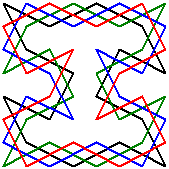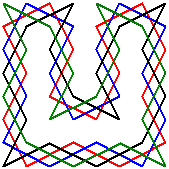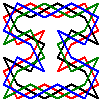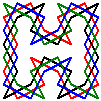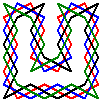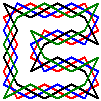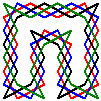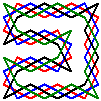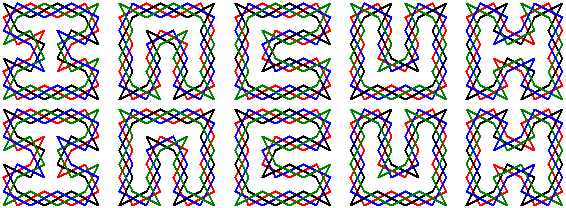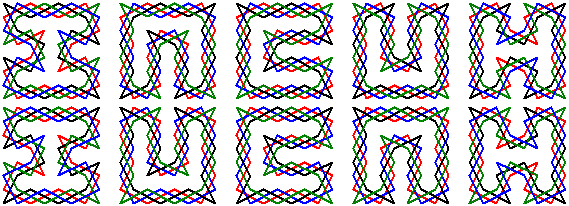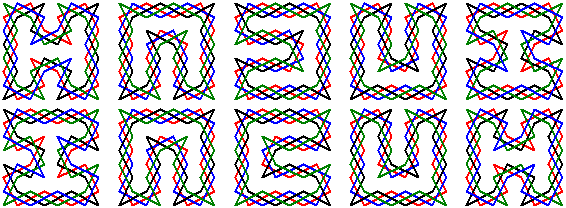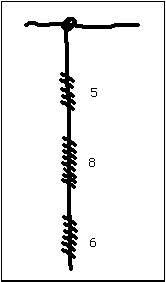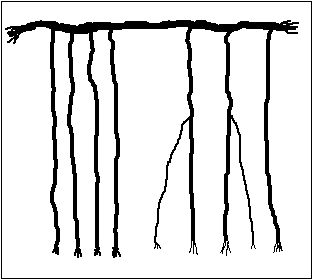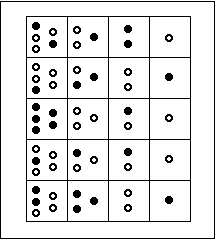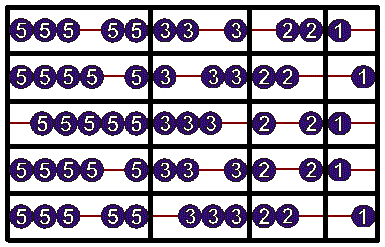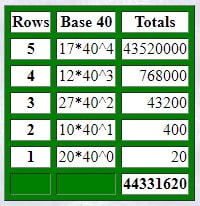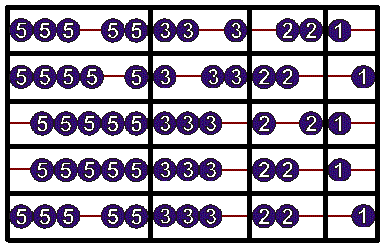I-N-C-U-H Knight's Tours
The following two graphics, Incuh-I and Incuh-U, are each built from Combined Mini Knight's Tours-21 and Tours-22 from 16-Move Closed Mini Knight's Tours with diamond and square patterns that can be manipulated to create new alpha-numeric characters, ciphers, or codes. In fact, the title of this webpage, I-N-C-U-H Knight's Tours, comes from those two modular Knight's Tour graphics. I-N-C-U-H is a play on the word: INCA.
As you view the various alpha-numeric characters created by the 16-move mini Knight's Tours, you may notice that they resemble Mesoamerican writings of Central and South America prior to the 17th century incorporated by the Olmec, Mayan, or partially by the Aztec people.
As you view the various alpha-numeric characters created by the 16-move mini Knight's Tours, you may notice that they resemble Mesoamerican writings of Central and South America prior to the 17th century incorporated by the Olmec, Mayan, or partially by the Aztec people.
Rotating copies of the previous Knight's Tour letters make the following shapes:
After looking at the shapes, I noticed I could use five of the shapes to make the word: I-N-C-U-H. While copying and pasting the I-N-C-U-H Knight's Tour letters, I noticed that they made neat patterns of dots and bars when being overlapped or partially overlapped with each other. I will provide just a few examples.
The following alpha-numeric characters could possibly be considered part of the lost writings of the Inca, but that would be a stretch of the imagination since no known writings have yet to be found. It might be better to view them as characters from an alphabet of a futuristic people called INCUH.
The following alpha-numeric characters could possibly be considered part of the lost writings of the Inca, but that would be a stretch of the imagination since no known writings have yet to be found. It might be better to view them as characters from an alphabet of a futuristic people called INCUH.
Partly overlapped copies of I-N-C-U-H Knight's Tour Letters
Partly overlapped mirror copies of I-N-C-U-H Knight's Tour Letters
Partly overlapped, flipped, and reversed copies of I-N-C-U-H Knight's Tour Letters.
Completely overlapped, flipped, and reversed copies of I-N-C-U-H Knight's Tour Letters.
One of the most amazing things about the previous overlapped characters, is that they represent a vigesimal (base 20) numbering system also used by the Olmec, Mayan, and Aztec people of the past. Each long bar is made up of five dots. Smaller bars are a combination of two, three, or four dots. Each dot represents a single unit. There can be four long bars surrounded by space (shown here as Knight's Tour moves).
Therefore, four long bars equals twenty, the same number used in the vigesimal system. The Mayans used 0-19. Zero would be represented by a clam-shell type character, while the number 19 would be represented by three long bars on top of each other with four separated dots positioned across the top of the top bar.
Therefore, four long bars equals twenty, the same number used in the vigesimal system. The Mayans used 0-19. Zero would be represented by a clam-shell type character, while the number 19 would be represented by three long bars on top of each other with four separated dots positioned across the top of the top bar.
Though the Inca had no known written language, they did use various colored cotton strings with knots representing numbers from a base 10 numbering system. These strings were called quipu, sometimes spelled khipu. Many cultures use their alphabet to represent both numbers and letters such as the Hebrews or the Greeks.
It is not unlikely that the Inca also used their knotted string numbers as letters, or at least by combining several strings with different numbers to represent city names, titles of people, livestock names, names of the seasons or months, and perhaps everything else of major consequence.
It is not unlikely that the Inca also used their knotted string numbers as letters, or at least by combining several strings with different numbers to represent city names, titles of people, livestock names, names of the seasons or months, and perhaps everything else of major consequence.
The following images of quipu come from www-history.mcs.st-and.ac.uk.
The Inca people also had another interesting counting device called a Yupana. The image below is an Inca Yupana counting device. The next image is my abacus-like design based on the yupana. Each row of digits in the abacus adds up to 39. So I figure, as does Nicolino De Pasquale, an Italian engineer, that the yupana may be working on a base 40 (0-39) numbering system. The analysis I've done on the yupana has been without prior knowledge of Pasquale's work.
Numbers shown in the five rows of the abacus from bottom to top match the numbers in the five rows of the Yupana. The numbers individually add up to 20, 10, 27, 12, 17.
The last four digits from the total above: "1620," look like a year. Try figuring out the totals for the yupana/abacus shown below. Hint, the total is very close to the same total for the yupana/abacus shown above.
The Incas normally used a base 10 numbering system for their record keeping. The abacus, or Inca yupana may have been used for a sacred calendar, or possibly a manual calculator for the tax gatherer, or to keep track of portions of grain, other produce, livestock, or for engineering mathematics.
